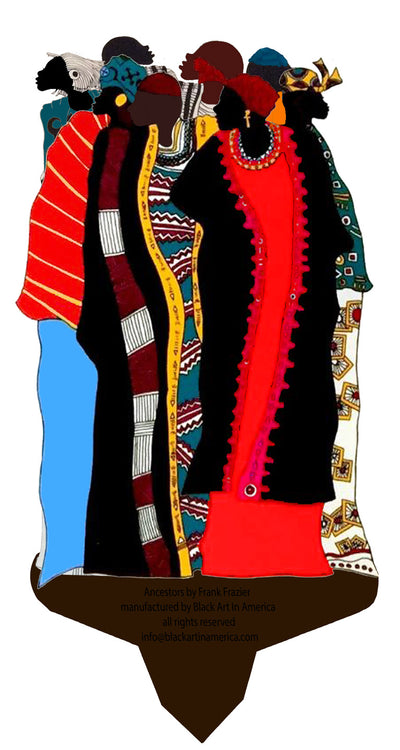Barthe, Richmond, (Black Narcissus)
Barthe, Richmond, (Black Narcissus)
"Black Narcissus" by Richmond Barthe
18.75 inches height, bronze sculpture on the base
with dark brown patina, (1929)
Richmond Barthe was born on January 28, 1901, in Bay St. Louis, Mississippi on land that had once been part of a large property owned by his maternal grandfather. His parents, Richmond Barthe, Sr. and Marie Clementine (Robateau) Barthe, were of African, French, Spanish, and Native American descent. His father died, when Barthe was just a few months old. From that point, his mother supported the family by working as a dressmaker. Later, she married William Franklin, Barthe’s godfather. Barthe was one of the first sculptors to focus on blacks as his main subjects. During the 1930s and 1940s, when he reached the height of his career, Barthe achieved critical acclaim, commercial success, and widespread popularity. The African American community, in particular, responded positively to Barthe’s sympathetic portrayals of blacks. “Aesthetically, he brought a new insight to the individuality and physical grace of all types of black people,”Romare Bearden and Harry Henderson wrote in A History of African-American Artists.
Barthe’s sculptures have been collected by the Whitney Museum of American Art, the Metropolitan Museum of Art, and the Smithsonian Institution, as well as many other museums and universities. His most famous public works include an eagle that stands in front of the Social Security Building in Washington, DC, and a 40-foot statue of Haitian revolutionary Jean Jacques Dessalines, which he created for the city of Port-au-Prince. Barthe also designed several Haitian coins that are still in use.
Barthe took a traditional approach to sculpture, sometimes exaggerating certain aspects of a figure, but always maintaining a strong undercurrent of realism. After World War II, when the art world became interested in more abstract forms of expression, his career waned. Abstract sculpture did not hold an attraction for Barthe, who remained a traditionalist. “All my life I have been interested in trying to capture the spiritual quality I see in people, and I feel that the human figure as God made it, is the best means of expressing this spirit in man,” he was quoted as saying in Great Negroes, Past and Present.
Sculptor.Solo shows included William Grant Still Community Art Center, 1978; Inst. Jamaica, 1959; Montclair Art Museum, NJ, 1949; Margaret Brown Galleries, Boston, MA, 1947; Grand Central Art Galleries, NY, NY, 1947; Sayville Playhouse, NY, NY, 1945;Intl .Print Soc., 1945; DePorres Interracial Center, 1945; South Side Art Ctr, Chicago, IL, 1942; Arden Galleries, New York, NY, 1939; Delphic Studios, 1935; Univ. of Wisconsin-Madison, 1931-33; Grand Rapids Art Gallery, Ml, 1930.
Numerous group shows, including Metropolitan Museum of Art, New York, NY; Guggenheim Museum, New York, NY; Whitney Museum of American Art, New York, NY; Chicago World’s Fair; Philadelphia Museum of Art; Afro-American History and Culture Museum, Philadelphia, PA; Los Angeles County Art Museum; Dallas Museum of Fine Arts.
Represented in permanent collections of Whitney Museum of American Art, Metropolitan Museum of Art, Smithsonian Institution, Art Institute of Chicago, Jamaican Public Library, Virginia Museum of Fine Arts, Los Angeles County Art Museum, Yale Univ. Museum, Howard Univ.Gallery of Art, Tuskegee Univ. Gallery of Art, and others.
Awards: Julius Rosenwald fund fellowship, 1930; Guggenheim fellowship, 1940; “Artists for Victory” prize, 1942.Commissions for busts of Booker T. Washington and Dr. George Washington Carver, Hall of Fame; sculpture for Social Security Bldg., Washington, D.C.; monuments of Toussaint L’Ouverture and General Dessalines, Port-au-Prince, Haiti; designs for Haitian coins.
Barthe’s artistic ability was discovered early; his mother claimed that “Jimmie,” as she called him, could draw before he could walk. “When I was crawling on the floor, my mother gave me paper and pencil to play with,” Barthe was quoted as saying in A History of African-American Artists. “It kept me quiet while she did her errands. At six years old I started painting. A lady my mother sewed for gave me a set of watercolors. By that time, I could draw very well.”
The family were devout Catholics. Barthe attended St. Rose de Lima Parochial School, then Valena Jones High School, leaving when he was 14. He then held various jobs in a restaurant, an office, and helping his stepfather on the ice truck. However, one of his stepfather’s white customers, an artist herself, was concerned that carrying cold ice on his shoulder might give him rheumatism and prevent him from painting. She introduced him to some white friends, the Pond family, who hired him as a household servant.
Barthe moved with the Ponds to New Orleans, where he lived for the next nine years. The Ponds held liberal views about race for their time, and treated Barthe more as a member of the family than as a servant. They included him in social events in their home, took him to the theater, and encouraged him in his art. During his years with the Ponds, Barthe learned to feel comfortable in a range of social situations—a skill that would help him later in his career, when he was often commissioned by wealthy people to sculpt their portraits.
In his free time, Barthe continued to work on his drawing, copying paintings that the Ponds owned or reproductions from their library. When Barthe was 23, he did his first oil painting, a portrait of Christ, and donated it to a local church to be auctioned at its charity bazaar. Father Kane, the parish priest, was astounded that the artist was a butler with no art training and decided that Barthe should go to art school. At the time, no local schools would accept black students, but Father Kane would not be deterred. He took up a collection from his friends, added some of his own money, and sent Barthe north, to the Art Institute of Chicago.
- Secure payments
- Low stock - 1 item left
- Inventory on the way




































